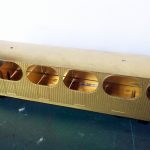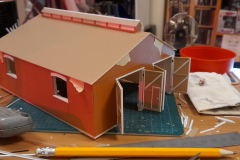9 made it to the April online meeting.
Tim Williams showed us progress on Insulation Lumber with his 3D printed mounts allowing the HOf points to be operated via Servos connecting with wire-in -tube. The use of the wires allowed the servos and their mounts to be hidden within the scenery rather than needing to be adjacent to the point tie bar, with some wire runs being 12-15″ in length to achieve this.


Blair Hobson had been working on his new HOe layout and demonstrated progress with one of his TU 47 diesels running around the layout.


Ben showed us progress on his industrial layout, where the loco shed had been glued together with its ventilated clerestory made using corrugated sections to represent the louvered vents and the bracing on the doors corrected. This and the other buildings had been joined by another that looked remarkably like a classic tower brew house and Ben declared that his layout was now ‘officially’ a brewery! On the motive power front Ben had fitted short lengths of wire to the loco buffer beams to act as delay latches for the Greenwich couplings based on a method from Paul Windle.


Charlie Forbes took us through how he had built his Campbelltown & Macrihanish coaches from the Worsley Works etch, including forming the tumblehome in the sides using 15 mm copper pipe and the ingenious jig made from a bit of wood and a couple of dressmaking pins that he had used to fit the balcony floors and steps at each end of the coach.



Mac Strong showed us a couple of Minitrains locos, a Gmeinder and a Plymouth, that he had fitted with Zimo DCC chips. There was also some discussion about chipping other locos in his 009 fleet.

David Churchill had been working on a Chemins de Fer du Calvados (60cm gauge) semi open coach using the Worsley Works ‘scratch-aid’ kit and talked a little about how he puts them together (essentially soldering one side to one end to form two L shapes then soldering these together to form a box and adjusting that to make it square).

Julien Webb had been making slow progress with his pair of large Baldwin 2-8-0 locos, but was able to show ‘Victoria’ running on Xavier’s Creek.

Peter Ashby joining us from Kent showed us some photos of his old 009 layout with a Langley double fairlie handling trains that could be up to 8 feet long.
















